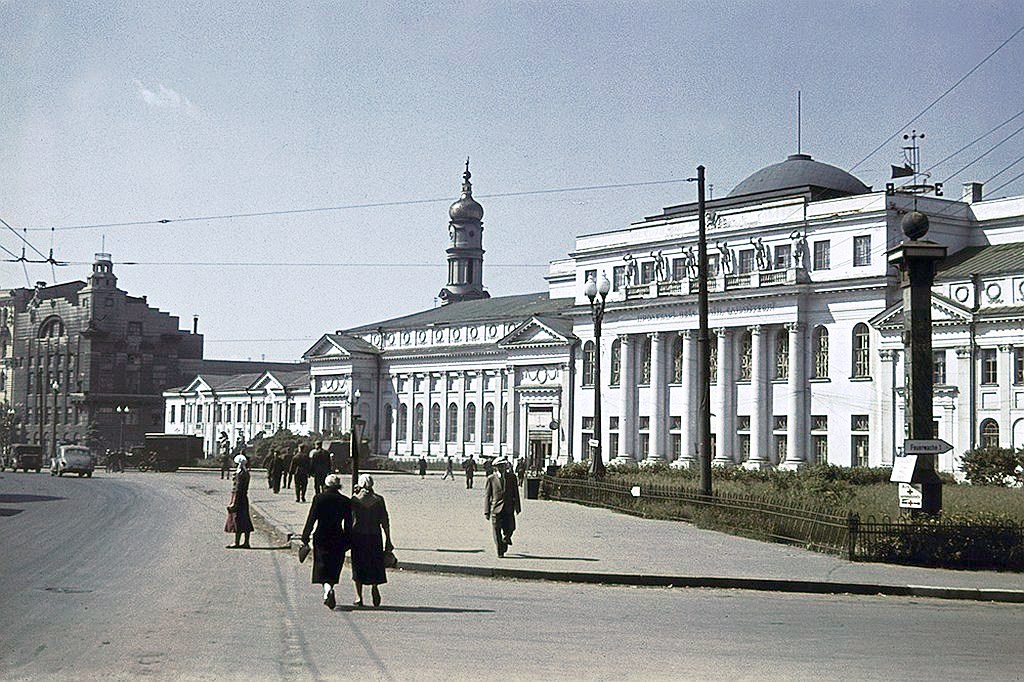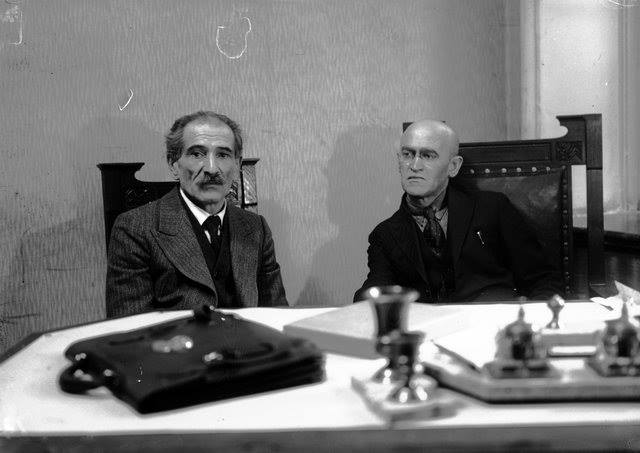|
Komunistishe Fon
''Komunistishe fon'' ( yi, קאָמוניסטישע פֿאָן, 'Communist Banner'), also known as ''Komfon'', was a Union of Soviet Socialist Republics, Soviet Yiddish newspaper published in Kiev 1919–1924. The newspaper was the result of the merger of two previously non-communist newspapers, ''Naye tsayt'' of the Fareynikte party and the ''Folkstsaytung (Kyiv), Folkstsaytung'' of the General Jewish Labour Bund in Lithuania, Poland and Russia, Bund party.Estraikh, Gennady. ''The Yiddish-Language Communist Press'', in Frankel, Jonathan (ed.), ''Studies in Contemporary Jewry. Vol. 20, Dark Times, Dire Decisions : Jews and Communism''. New York City: Oxford University Press, 2005. p. 64 ''Kommunistishe fon'' was the organ of the Jewish Communist Union in Ukraine, Komfarband, and later became the organ of the Main Bureau of the Yevsektsia, Jewish sections of the Communist Party (bolshevik) of Ukraine. Henekh Kazakevitch was the editor of ''Komfon''. Between the 9th Congress of the R ... [...More Info...] [...Related Items...] OR: [Wikipedia] [Google] [Baidu] |
Communist Party (bolshevik) Of Ukraine
The Communist Party of Ukraine ( uk, Комуністична Партія України ''Komunistychna Partiya Ukrayiny'', КПУ, ''KPU''; russian: Коммунистическая партия Украины) was the founding and ruling political party of the Ukrainian Soviet Socialist Republic operated as a republican branch (union republics) of the Communist Party of the Soviet Union (CPSU).Pyrih, R. Communist Party of Ukraine, the Soviet period (КОМУНІСТИЧНА ПАРТІЯ УКРАЇНИ РАДЯНСЬКОЇ ДОБИ)'. Encyclopedia of History of Ukraine. 2007 No decision of the government of Ukraine (Council of Ministers) was adopted without approval of the Central Committee of the Communist Party of Ukraine. The Communist Party of Ukraine is not one and the same party as the Ukrainian Communist Party or Ukrainian Communist Party (Borotbists). Founded as the Communist Party (Bolsheviks) of Ukraine (CP(b)U) in 1918 in Moscow, Russian SFSR, it was the sole gov ... [...More Info...] [...Related Items...] OR: [Wikipedia] [Google] [Baidu] |
Defunct Yiddish-language Newspapers Published In Ukraine
Defunct (no longer in use or active) may refer to: * ''Defunct'' (video game), 2014 * Zombie process or defunct process, in Unix-like operating systems See also * * :Former entities * End-of-life product * Obsolescence {{Disambiguation ... [...More Info...] [...Related Items...] OR: [Wikipedia] [Google] [Baidu] |
Yiddish Communist Newspapers
Yiddish (, or , ''yidish'' or ''idish'', , ; , ''Yidish-Taytsh'', ) is a West Germanic language historically spoken by Ashkenazi Jews. It originated during the 9th century in Central Europe, providing the nascent Ashkenazi community with a vernacular based on High German fused with many elements taken from Hebrew (notably Mishnaic) and to some extent Aramaic. Most varieties of Yiddish include elements of Slavic languages and the vocabulary contains traces of Romance languages.Aram Yardumian"A Tale of Two Hypotheses: Genetics and the Ethnogenesis of Ashkenazi Jewry".University of Pennsylvania. 2013. Yiddish is primarily written in the Hebrew alphabet. Prior to World War II, its worldwide peak was 11 million, with the number of speakers in the United States and Canada then totaling 150,000. Eighty-five percent of the approximately six million Jews who were murdered in the Holocaust were Yiddish speakers,Solomon Birnbaum, ''Grammatik der jiddischen Sprache'' (4., erg. Aufl., Hambu ... [...More Info...] [...Related Items...] OR: [Wikipedia] [Google] [Baidu] |
Publications Disestablished In 1924
To publish is to make content available to the general public.Berne Convention, article 3(3) URL last accessed 2010-05-10.Universal Copyright Convention, Geneva text (1952), article VI . URL last accessed 2010-05-10. While specific use of the term may vary among countries, it is usually applied to text, images, or other content, including paper ( |
Newspapers Established In 1919
A newspaper is a periodical publication containing written information about current events and is often typed in black ink with a white or gray background. Newspapers can cover a wide variety of fields such as politics, business, sports and art, and often include materials such as opinion columns, weather forecasts, reviews of local services, obituaries, birth notices, crosswords, editorial cartoons, comic strips, and advice columns. Most newspapers are businesses, and they pay their expenses with a mixture of subscription revenue, newsstand sales, and advertising revenue. The journalism organizations that publish newspapers are themselves often metonymically called newspapers. Newspapers have traditionally been published in print (usually on cheap, low-grade paper called newsprint). However, today most newspapers are also published on websites as online newspapers, and some have even abandoned their print versions entirely. Newspapers developed in the 17th century, as ... [...More Info...] [...Related Items...] OR: [Wikipedia] [Google] [Baidu] |
Der Shtern (Kharkov)
''Der shtern'' ( yi, דער שטערן, 'The Star') was a Yiddish language daily newspaper published from Kharkov, Ukrainian SSR between 1925 and 1941. It was an organ of the Central Committee of the Communist Party (bolsheviks) of Ukraine and the All-Ukrainian Council of Trade Unions.National Library of Russia. Yiddish Newspapers (in the Latin alphabet)' M. Levitan served as editor in chief of the newspaper. ''Der shtern'' replaced ''Komunistishe fon'' as the main Yiddish newspaper in Soviet Ukraine. The first issue of ''Der shtern'' was published in May 1925. In its initial phase ''Der shtern'' was the largest Yiddish newspaper in the Soviet Union, as well. It was printed around 12,000 copies, a larger number than that of the Moscow-based ''Der emes ''Der Emes'' (in Yiddish: , meaning 'The Truth', from he, אמת, emeth) was a Soviet newspaper in Yiddish. A continuation of the short-lived '' Di varhayt'', ''Der Emes'' began publishing in Moscow on August 8, 1918.Kotlerman, ... [...More Info...] [...Related Items...] OR: [Wikipedia] [Google] [Baidu] |
Kharkov
Kharkiv ( uk, Ха́рків, ), also known as Kharkov (russian: Харькoв, ), is the second-largest city and municipality in Ukraine.Kharkiv "never had eastern-western conflicts" '''' (23 October 2014) Located in the northeast of the country, it is the largest city of the historic region. Kharkiv is the of |
Der Emes
''Der Emes'' (in Yiddish: , meaning 'The Truth', from he, אמת, emeth) was a Soviet newspaper in Yiddish. A continuation of the short-lived '' Di varhayt'', ''Der Emes'' began publishing in Moscow on August 8, 1918.Kotlerman, Boris (August 5, 2010).Emes, Der" ''The YIVO Encyclopedia of Jews in Eastern Europe''. Retrieved June 11, 2020. The publisher was the Central Committee of the Russian Communist Party (Bolsheviks). Moishe Litvakov was its editor-in-chief from 1921 until his arrest in the fall of 1937; after that, the newspaper was headed by an anonymous "editorial board". From January 7, 1921 to March 1930 ''Der Emes'' appeared as the organ of the Central Bureau of Yevsektsiya. In January 1939 the campaign against Yiddish culture in the USSR became widespread, and ''Der Emes'' was liquidated. Featured highlights ''Der Emes'' was a conductor of the Soviet propaganda and ideas directed at ordinary Jews in the USSR and all around the world. The most prominent line of the n ... [...More Info...] [...Related Items...] OR: [Wikipedia] [Google] [Baidu] |
Red Army
The Workers' and Peasants' Red Army (Russian: Рабо́че-крестья́нская Кра́сная армия),) often shortened to the Red Army, was the army and air force of the Russian Soviet Federative Socialist Republic and, after 1922, the Union of Soviet Socialist Republics. The army was established in January 1918. The Bolsheviks raised an army to oppose the military confederations (especially the various groups collectively known as the White Army) of their adversaries during the Russian Civil War. Starting in February 1946, the Red Army, along with the Soviet Navy, embodied the main component of the Soviet Armed Forces; taking the official name of "Soviet Army", until its dissolution in 1991. The Red Army provided the largest land force in the Allied victory in the European theatre of World War II, and its invasion of Manchuria assisted the unconditional surrender of Imperial Japan. During operations on the Eastern Front, it accounted for 75–80% of casual ... [...More Info...] [...Related Items...] OR: [Wikipedia] [Google] [Baidu] |
10th Congress Of The Russian Communist Party (Bolsheviks)
The 10th Congress of the Russian Communist Party (Bolsheviks) was held during March 8–16, 1921 in Moscow, Russia. The congress dealt with the issues of the party opposition, the New Economic Policy, and the Kronstadt Rebellion, which started halfway through the Congress. The Congress was attended by 694 voting delegates and 296 non-voting delegates. Agenda The Agenda consisted of: # Report of the Central Committee; # Report of the Control Commission; # The trade unions' economic role; # The Socialist Republic in a capitalist encirclement foreign trade, concessions, etc.; # Food supply, surplus-food appropriation, tax in kind and fuel crisis, # Problems of Party organisation; # The Party's current tasks in the nationalities question; # Reorganisation of the army and the militia question; # The Chief Administration for Political Education and the Party's propaganda and agitation work; # Report of the R.C.P.'s representative in the Comintern, and its current tasks; # Report of t ... [...More Info...] [...Related Items...] OR: [Wikipedia] [Google] [Baidu] |
9th Congress Of The Russian Communist Party (Bolsheviks)
9 (nine) is the natural number following and preceding . Evolution of the Arabic digit In the beginning, various Indians wrote a digit 9 similar in shape to the modern closing question mark without the bottom dot. The Kshatrapa, Andhra and Gupta started curving the bottom vertical line coming up with a -look-alike. The Nagari continued the bottom stroke to make a circle and enclose the 3-look-alike, in much the same way that the sign @ encircles a lowercase ''a''. As time went on, the enclosing circle became bigger and its line continued beyond the circle downwards, as the 3-look-alike became smaller. Soon, all that was left of the 3-look-alike was a squiggle. The Arabs simply connected that squiggle to the downward stroke at the middle and subsequent European change was purely cosmetic. While the shape of the glyph for the digit 9 has an ascender in most modern typefaces, in typefaces with text figures the character usually has a descender, as, for example, in . The mod ... [...More Info...] [...Related Items...] OR: [Wikipedia] [Google] [Baidu] |







.jpg)